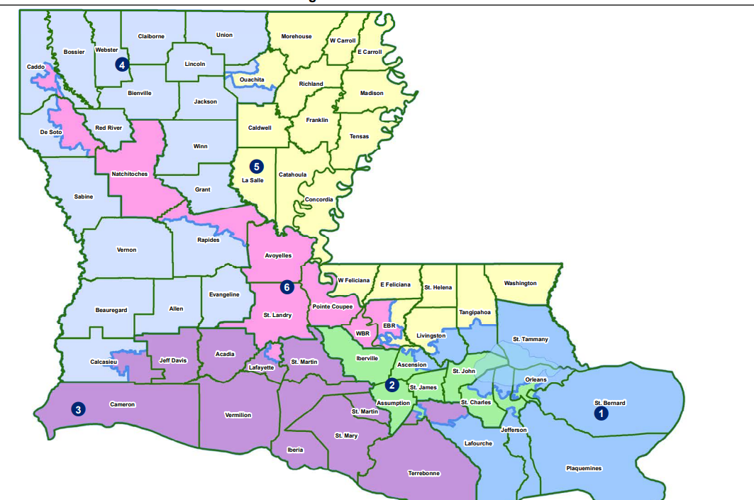WASHINGTON – Louisiana Secretary of State Nancy Landry asked the panel of three federal judges trying to settle on maps for this fall’s congressional elections to make up their minds by the middle of next week to meet the May 15 deadline she says her office must meet to properly stage the Nov. 4 election.
Such a hard deadline would force the panel – and other actors in the process – to act quickly. Multiple parties already have filed appeals with the U.S. Supreme Court, the next rung up in the appellate process.
A couple of big questions are at issue: First, will the new maps favor the election of two Black candidates and four White ones, like the map the Legislature drew up in January? Or will they revert to something closer to the maps the Legislature drew two years earlier, which tilted toward a delegation with five White members and one Black one who now represent Louisiana?
And if the map does change to a 4-2 configuration, which member or members will see the biggest change to their districts?
Two members of the three-judge panel – U.S. District Judges Robert Summerhays and David Joseph, both nominated by President Donald Trump – last week rejected the map the Legislature drew earlier this year. That map had created a new majority-Black district, largely at the expense of Rep. Garret Graves, a White Republican from Baton Rouge.
The 2-1 decision left the six members of the U.S. House in limbo in terms of which districts they'll be running for in November. Currently, there is no controlling map.
The panel, which was chosen by the chief judge of the 5th U.S. Circuit Court of Appeals, held a status conference behind closed doors Monday to decide what to do next.
Other federal courts had raised questions about whether Louisiana's maps are unfair to Black voters. About a third of Louisianans are Black, but just one of the six House districts has traditionally been drawn in such a way that a Black member is likely to be elected.
This year, legislators redrew those district lines to create a second majority Black district, while also ensuring that the House’s two top leaders – Speaker Mike Johnson, R-Benton, and House Majority Leader Steve Scalise, R-Jefferson – ran before as many of the overwhelmingly White voters who had elected them in the past as possible. They also wanted to protect Rep. Julia Letlow, R-Start.
That meant putting Graves into a mostly Black district.
The debate highlights tension between the Voting Rights Act, passed in 1965 to enforce constitutional protections of minority voters, and a half-century of judicial interpretations about how to apply traditional redistricting principles, such as geographical compactness of voters with similar interests.
The panel on Monday asked the secretary of state to brief them before the night ends on the downsides of postponing the decision on when the election maps need to be ready.
Legally, Louisiana legislators should have the first crack at fixing the flaws found by the panel’s majority. The state argues that constitutional and legal procedures require 12 days for the Legislature to draft and pass a new map.
The Legislature needs to explain the feasibility of “enacting a new congressional map in time for the 2024 Congressional election,” the panel ordered. “Among the other items discussed, the brief shall clearly state whether there is a legislative vehicle to enact a new legislative vehicle to enact a new congressional district map during the 2024 regular session.”
The Legislature is scheduled to adjourn June 3.
Two lawyers attending the hearing predicted the panel would make its decisions by Thursday at the latest. The first key decision is whether to accept the state’s argument that May 15 is a hard deadline.
Attorney General Liz Murrill, who represents Landry, said that she would prefer the fall election use the Legislature’s map with two minority-majority districts that the panel rejected last week while the Supreme Court sorts out the appeals. Failing that, Murrill recommended using the 2022 districts that elected the five White Republican and one Black representatives serving now. That map is already loaded in state computers and would minimize administrative problems, she said.
“The panel seems inclined toward creating more chaos in our Congressional elections in a presidential election year. While we will not have a definitive ruling for another day at least, we appear to be heading to the Supreme Court this week,” Murrill said in her statement, posted to X. “The Supreme Court needs to provide instructions to state legislatures so states are not on a perpetual federal litigation roller coaster over good-faith efforts at redistricting. It’s confusing to voters, it’s expensive for taxpayers, and it’s inconsistent with the federal Constitution.”
The 2022 map has been revoked by the Legislature and was found not to comply with the Voting Rights Act by Chief U.S. District Judge Shelly Dick, of Baton Rouge, in a ruling that has been endorsed by two other panels of federal judges.
The panel now considering the matter ordered the parties to submit their recommended maps by Thursday.
Plaintiffs suggested maps their experts drew that kept the configuration of five White and one Black congresspersons. The intervenors, several groups of Black voters, propose alternative maps that would give two Black and four White candidates a fighting chance.
The panel, if there is enough time, could hold a hearing to determine which of the maps meet the tests for compactness and communities of interest to meet the criteria outlined in earlier court decisions.
“A lot of lawyering will happen between now and when Louisiana has a final map,” said Victoria Wenger, who as counsel with the NAACP Legal Defense and Educational Fund Inc., represents some but not all of the voters wanting a second minority-majority congressional district.





